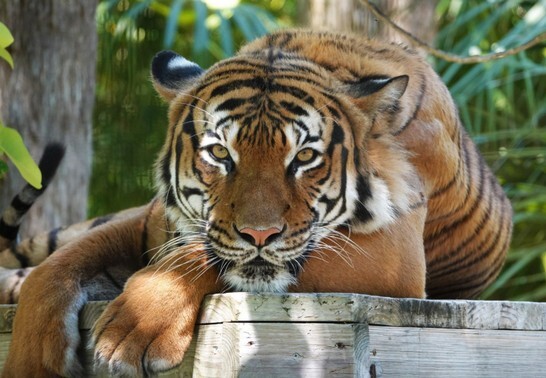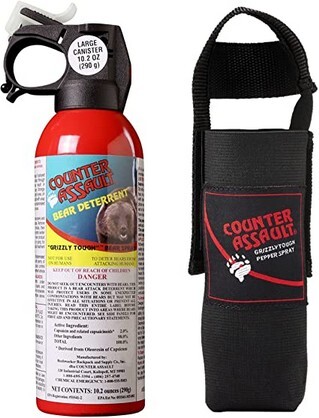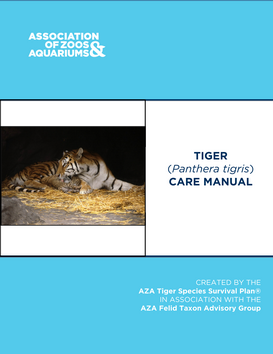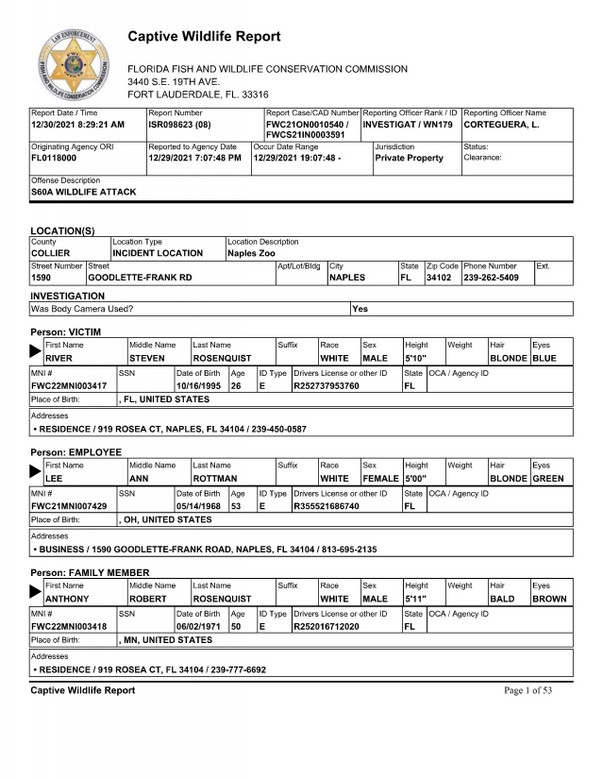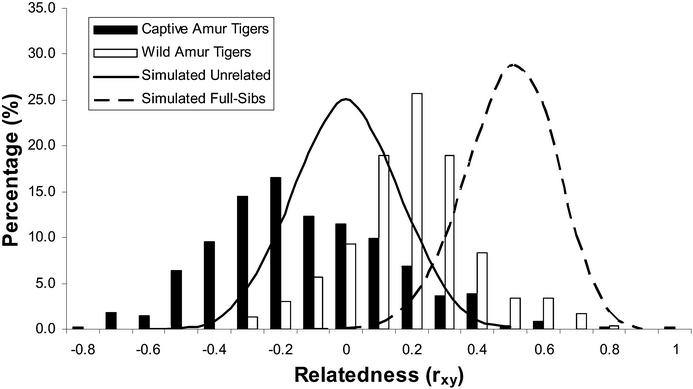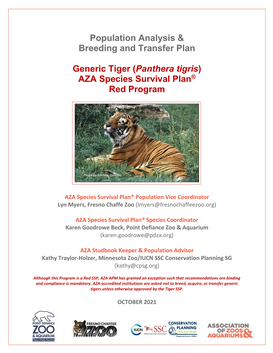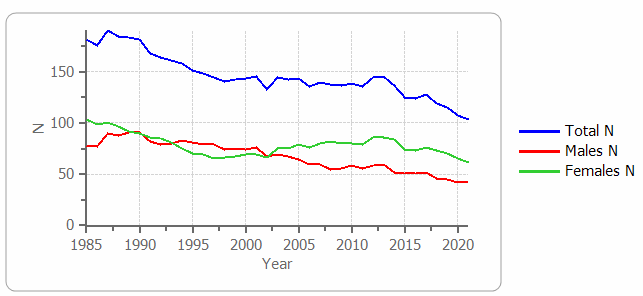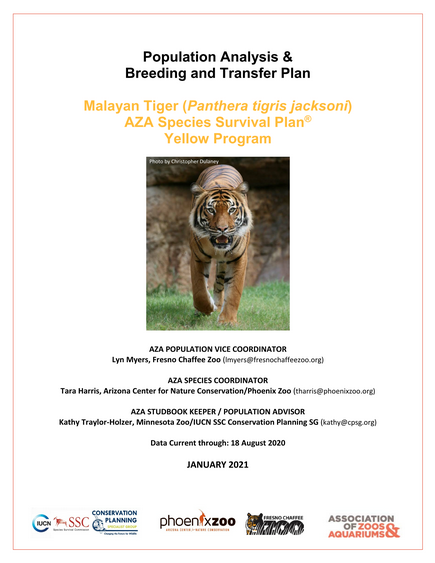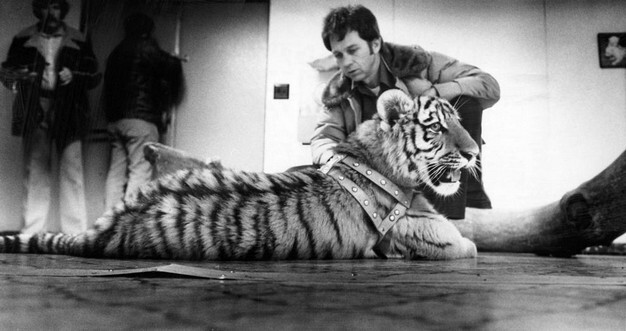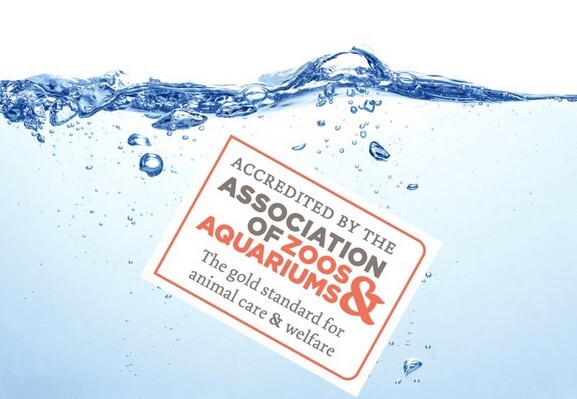
Association of Zoos and Aquariums
Drowning in Failure
Eight endangered tiger deaths in 15 months and a "Species Survival Program" down 36% from when it was first started 40 years ago.
Updated: November 21, 2025
As 2022 starts, we enter into the "Year of the Tiger" , seen every twelve years. Definitely something positive to look towards considering how the bad fate the tiger species was subjected to in 2021 by several zoos accredited by the Association of Zoos and Aquariums, (AZA)
NAWA is a very strong supporter for today's zoos, both public and private, large and small. It is an undisputer fact that the single most important foundation for conservation is awareness. Good animal welfare ideas entail grappling with dissonances and discrepancies arising from inconsistent or conflicting views (i.e., listening to all opinions).While good research certainly defies simple conceptualization, it is this process of constant reflection, open-mindedness, sharing of information, and interpretation of solid facts (not politics) that renders the animal welfare discussion process fluid, dynamic, and accurate in order for owners to make sound decisions related to any species that may be in their care. So when failures occur it is important to examine and to learn from these events.
There are many good associations out there. Many offer an accreditation program within their thoughts and beliefs related to animal care and welfare. If zoo's and related facilities place all their beliefs in just one association's standards and practice, (especially with one that will not show the accreditation process), such tragic event(s) should be scrutinized even more carefully.
The tiger species has been subjected to much in 2021, all related to the AZA. We looked into just the last twelve months of such tragedies within the tiger population of these AZA accredited zoos and found a very disturbing pattern.
This page will dissuce the following:
Naples Zoo failure:
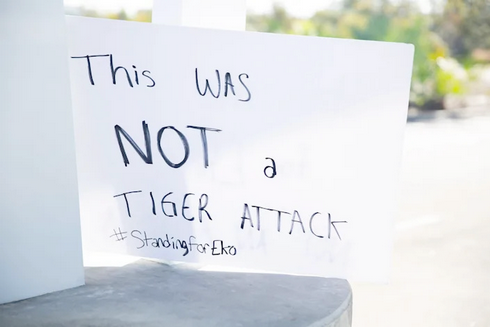
A sign that states "This was NOT a tiger attack. #StandingforEko" left in the parking lot of the Naples Zoo .
What is known:
What happened at the Naples Zoo?
According to the Collier County Sheriff's Office, 26-year-old Naples man River Rosenquist was working at the zoo after hours on Wednesday when he breached the tiger's enclosure. Rosenquist allegedly scaled a 4.5 foot fence in an attempt to pet or feed Eko, the 8-year-old tiger. The animal then bit down on Rosenquist's arm and would not let go. According to sheriff's reports, a deputy had to shoot the tiger to get him to release the man.
The rescue was captured on a CCSO deputy's bodycam video. Rosenquist was taken to Lee Memorial Hospital in Fort Myers to be treated for his serious injuries. His condition is unknown, and as of Saturday, a hospital official said his name was not on the patient directory.
Bodycam video: 'Please, please help me,' man caught in tiger's mouth shrieks (VIEWER WARNING)
River Rosenquist
What was the man doing at the Naples Zoo after hours?
Rosenquist was contracted by HMI Commercial Cleaning as part of a crew tasked with cleaning the restrooms and gift shop after operating hours. Workers for the company are not authorized to enter or clean animal habitats.
Zoo officials said Friday (December 31, 2021) since that it would no longer be using HMI.
HMI Commercial Cleaning: What we know about the Naples Zoo cleaning company that employed mauled man
Who was "Eko" the Malayan tiger?
Eight-year-old Eko was the only tiger at the Naples Zoo. Malayan tigers are rare and critically endangered - around just 200 of the species are left in the wild. Eko was born in 2013 at Arkansas' Little Rock Zoo as part of a program to breed endangered species and raised at the Woodland Park Zoo in Seattle with his two littermates. He was moved to the Naples Zoo at Caribbean Gardens at the end of 2019.
One of six subspecies of tigers, Malayan tigers are only found in the wild in peninsular Malaysia, where habitat loss, poaching and other human activities have threatened their existence. The subspecies is smaller than other tigers, with adults weighing between 220 - 264 pounds, but larger than Florida's own endangered wild cat, the panther.
Who was Eko?: Eko the Malayan tiger born in Arkansas, raised in Seattle, transported to Naples in 2020
Would a Taser or Pepper Spray have worked?
The short answer is:
Taser: YES
OC Spray: MAYBE
Tasers: The critical thing to remember is that there is generally a big difference between a "taser gun" and a "stun gun". Tasers are much more powerful than hand-held stun guns. The most important thing is that tasers are only useful in limited situations with big cats.
Tasers fire two probes on 15- to 35-foot lines, and to be effective, both probes must hit. When they do, 50,000 volts (compared to most stun guns at about 5,000 volts) jam the nervous system, causing temporary paralysis and a jolt of pain. As a last resort, the drive stun on the gun itself can inflict pain without incapacitating. Tiger's, which can reach 500 pounds, are susceptible to both.
In 2004 the St. Johns County Sheriffs Department (FL) was successful with such an incident and credited for saving lives. The type of taser that was used then was what was called the Mark 5 Taser (produced by Taser International). At the time, the Mark 5 was the best and most advanced taser on the market. Today, most law enforcement departments are equipped with the Taser X26, which is also produced by Taser International, but the technology has been extremely advanced.
OC capsicum spray (pepper spray): The topic of pepper spray strength is often a confusing and misinterpreted subject. This may be because potency levels are often purposely misconstrued by some manufacturers to seem stronger (Hint: 5.3 Million Scoville Heat Units) or other times due to misinformation. There are two common inaccurate measures of pepper spray strength and one true indicator of strength.
The one correct indicator of pepper spray potency, as recognized by the EPA & US Federal Government, is Major Capsaicinoids (MC). MC represents the strength of the entire formulation within your pepper spray. Typical sprays range from 0.18 to 1.33% MC. The higher the MC of the pepper spray, the greater the potency. Sprays with higher MC are more effective as well. A good example, Gasoline, is typically 87, 89 or 91 Octane. The higher gasoline's octane rating, the greater the fuels performance. Proof, another example, is the measure of liquor strength. The higher the proof, the stronger the liquor.
For hyper carnivores, (tigers, lions, bears), the spray must measure between 1.0% to 2.0% or higher of Major Capsaicinoids.
The pepper sprays mainly concentrate on the target's pH levels to gain the desired results. Most humans have around a pH level of 7- 7.8, while a bit cat can be between 11 -13. OC spray lowers the pH level low enough to start the irritation affects (ocular and nasal discharges and other irritants). So the OC spray used to be effective on a big cat that already has a higher pH level to start with, obviously needs to be stronger to bring the pH level lower to induce the effective desired results.
The two inaccurate measures of pepper spray strength are Oleoresin Capsicum percentages (OC%) & Scoville Heat Units (SHUs). Pepper sprays contain anywhere from 2-10% OC, but OC% only measures the amount of raw pepper or Oleoresin Capsicum (OC) within the pepper spray formulation. The OC% does not take into account the actual potency of that OC. SHUs are an inaccurate measure because they only measure the strength of the previously mentioned raw OC, which is then diluted from 90 to 98% because OC only measures between 2-10% of the formulation. Here is an example of how SHU can be misleading: a 5.3 Million SHU spray with 2% OC measures only 0.71% MC. while a 2 Million SHU spray with 10% OC measures 1.33% MC. So, which spray would be more potent? The 1.33 MC pepper spray is nearly twice the strength.
Did the Naples Zoo violate any laws or safety procedures?
The AZA has an extensive Tiger Husbandry Manual which address "Safety and Containment" in detail, (starting on page 14)
- It is highly recommended that tigers be brought indoors whenever severe weather is predicted, night or day.
- If non-animal staff (e.g., maintenance, IT, horticulture, etc.) are working in tiger areas, staff should provide close supervision if animals are present. This includes careful tracking of the number of people entering and leaving the area and strict instructions as to where they are allowed to go and what they are allowed to do.
- Non-zoo staff (e.g., contractors, guests, etc.) should be escorted at all times and provided careful instruction before entering the area.
- "Simple safety guidelines for working with tigers:"
- "Count your cats;"
- "Assume nothing;"
- "Trust no one;"
AZA's "Tiger Care Manual"
What comes next in the Naples Zoo tiger investigation?
In addition to the Naples Zoo conducting its own investigation and reviewing its safety protocols, the Florida Fish and Wildlife Commission is also investigating Wednesday's events. According to a representative of the FWC, the state agency has received information regarding the incident.
The FWC's Captive Wildlife section is currently investigating the incident. When the investigation is complete, the report will be available for release," Melody Kilborn, the FWC SW Region Public Information Director, said on Saturday. January 1, 2022. (Update Feb 4, 2022 - Investigation report: Florida Fish and Wildlife Commission - *WARNING* - Contains graphic images.)
Investigation report: Florida Fish and Wildlife Commission
*WARNING* - Contains graphic images.
AZA's complete failure.
Six big cats have died at the hands of AZA zoos in 15 months.
The Tiger Species Survival Plan manages three tiger populations as recommended by the 1992 Tiger Global Conservation Strategy and by the AZA Felid Taxon Advisory Group (TAG) - Amur (Panthera tigris altaica), Sumatran (P.t. sumatrae), and Malayan (P.t. jacksoni) tigers - with 150 spaces currently allotted to each.
As of August 2020, 272 tigers are maintained in 102 AZA or partner institutions, including 51 Malayan, 72 Sumatran, and 117 Amur tigers, as well as 32 generic (unknown pedigree) tigers. An additional 16 generic tigers are held by the International Exotic Feline Sanctuary (IEFS) in Boyd, Texas but as of October 2021 this "sanctuary" is out of "business", and no longer an AZA member facility.
The AZA also manages the Generic Tiger Species Survival Plan - Red List. This so called "Survival plan" is more of a contradiction in the title it touts, as this program is designed for one priority - to completely snuff out any other species of tigers that AZA is not controlling through it's SSP program.
The Generic Tiger Species Survival Plan - Red List was formed in 2009 for the purpose of managing non-pedigreed tigers of unverified origin and taxonomy to extinction in AZA member zoos. It is highly unlikely that any of these tigers are of pure taxonomic status and/or are unrelated to the existing managed SSP populations for Amur, Sumatran and Malayan tigers. However many scientist disagree - see - Subspecies Genetic Assignments of Worldwide Captive Tigers Increase Conservation Value of Captive Populations.
Captive vs Wild Amur Tigers - Relatedness
So much for the word "survival"
The program goal is to manage this population of generic tigers (taxonomic hybrids and/or tigers of unknown pedigree) to extinction. (page 4, Generic Tiger (Panthera tigris) AZA Species Survival Plan, Red Program - October 2021.)
As of 15 August 2021, there are 39 "generic" tigers (14 males; 25 females) at 12 AZA institutions in the US and Canada. The program goal is to manage this population of generic tigers (taxonomic hybrids and/or tigers of unknown pedigree) to extinction to increase the capacity of AZA institutions to hold, breed and manage tigers of known pedigree and management unit - namely, Amur (P.t. altaica), Malayan (P.t. jacksoni) and Sumatran (P.t. sumatrae) tigers. Of these 39 generic tigers, 25 are considered to be occupying "spaces" for tigers in 11 AZA-accredited institutions, while 14 are housed at the now failed (past AZA-accredited sanctuary), IEFS.
Watching a controlled "train-wreck"
To provide a comparison between an SSP that strives to save a species of tiger, verses a SSP that's single goal is to drive a particular tiger class to extinction, we looked at the Amur Tiger SSP and the Generic Tiger SSP and their past to present inventories, targeted goals, history, plans, and more. What we noticed was astonishing to the level of pernicious, so hold on !
The Amur Tiger SSP
The Amur Tiger SSP was established in 1981 and intentionally reduced tiger numbers, (Generic Tiger SSP) through demographic management to meet it's target population size of 150 individuals. The population was maintained at 130-160 individuals for over 20 years; however, low recruitment and a reduction in spaces has led to decline (~4% annually) over the past eight years. Reproductive success of recommended pairs and cub survival has been lower than expected in recent years, and "so-called" space constraints have limited breeding attempts.
- The numbers from AZA show us that the Amur Tiger SSP started it's nose dive in 1992 just 11 years of start and it's all time high.
- This decline is maintained from 1992 to 2012. Then in 2013 the bottom seems to have fallen out again and the same devastating pattern of decline drops even consistently sharper up to 2021.
- So in 40 years after the AZA starts this SSP, they are left with 36% less Amur Tigers than they started with in 1981. From 160 Amur Tigers just under 40 years ago to today's count of only 103.
- Even after the AZA started killing off the "so-called" generic tiger, it's population has declined by 78% - from 114 in 2009 in 42 institutions to 25 in 2021 in 11 institutions.
- AZA shows us that the "generic tiger" is now only taking up 10% in these zoos, but still the Amur Tiger SSP is crashing.
- The idea of AZA claiming "space constraints" is a big factor for the Amur SSP numbers to be crashing is just ludicrous and irresponsible.
Malayan Tiger SSP
The current SSP population began in 1990-92 with the importation of 1.3 tigers from Asia followed by modest breeding. Active management of this tiger subspecies began in 1998, when the decision was made by the SSP to expand this population and pursue the availability of additional founders from Southeast Asian zoos. The population quickly grew from 10 to over 40 individuals due to high reproductive success. During this time 60% of breeding recommendations produced a litter within one year, with mean litter size = 3.2 cubs and 30-day survival of 93%.
As the program was not making significant progress, five wild-caught tigers (taken from the wild from the very species the SSP says it is protecting), were imported in 2003 (dotted line on graph) and produced multiple litters. Population growth slowed due to many mishaps static concentrated breeding efforts with the imported founders, with breeding efforts eventually expanded to include all lineages.
In 2010 the program saw the programs highest achieved numbers peak. As of 2021 the program has dropped off by almost 17%.
Malayan Tiger SSP - inventory chart
--- Total --- Male --- Female
Note the jump in numbers is 2003, (dotted line). After thirteen years of static results the AZA/SSP had to go to the wild and capture more wild tigers in attempts to revive the programs progress.
Population Analysis & Breeding/Transfer Plan
Malayan Tiger
Now we look at the Generic Tiger SSP, Red List
a/k/a "hit list"
As of 15 August 2021, there are 39 "generic tigers" (14 males; 25 females) at 12 AZA institutions in the US and Canada.
Of these 39 generic tigers, 25 are considered to be occupying "spaces" for tigers in 11 AZA-accredited institutions, while 14 are housed at the now failed Texas sanctuary, International Exoctic Feline Sanctuary, (IEFS) which was AZA-accredited sanctuary but no longer.
As "IEFS" is no longer an AZA member institution as of October 2021; when combined with three tiger deaths in August-September 2021, this leaves 22 tigers (8 males; 14 females) at 9 AZA institutions as of October 2021.
AZA member institutions were requested to refrain from acquiring or breeding generic tigers from 2006-2009 but generic tiger numbers continued to rise. This management action became mandatory in Fall 2009 with the establishment of the Generic Tiger SSP. Since active management of the generic tiger population in AZA institutions began in 2009, the non-sanctuary population has declined by 78% - from 114 in 2009 in 42 institutions to 25 in 2021 in 11 institutions.
It is no secret that many zoo's argued with AZA over their mandate in 2009 especially since a large number of the "generic tigers" were white in color and AZA took the stance that white tigers had no conservation value. There is a mountain of documentation that this is far from the truth.
In fact AZA touts that since the launch of the Tiger SSP 2012 the Tiger Conservation Campaign which purpose is to encourage zoos to raise awareness about the plight of wild tigers and funding for their conservation the campaign has raised $1.2 million. ($1.2 million total for the last decade, $120,000 per year on average)
However here are just a couple of examples of contributing conservation efforts provided by the white tiger:
- An AZA accredited zoo had a single white tiger visit for a summer on exhibit. The zoo reported a 110% increase in attendance which translated to just over $10,560,000 for the year. ($10,560,000 for just one season!)
- After conservation officials announced that they were forced to abandon conservation efforts to keep the Manzanilla turtle from going extinct due to funding, the Emperor Valley Zoo who had just had a little of white tigers came to the rescue. Through their exhibit efforts these little-guys were able to single handedly able to produce the revenue to keep the conservation program of a totally different species alive, and saved the Manzanilla turtle from extinction. "From viewing the iconic white tiger cubs at the Emperor Valley Zoo to saving endangered leatherback turtles at Manzanilla, the link in the conservation chain has certainly been strengthened, conservationists said."
These are just a couple of small examples of the conservation value or the generic and white tiger.
How is the Generic and White Tiger assisting in wildlife conservation?
"The answer is simple. You justify white tigers in exactly the same way you justify traveling giant pandas, koalas and other high visible animals which, through the ability to catch the public fancy, significantly enhances public support and therefore the financial well-being of your institution, [zoo's that exhibit white tigers] see results that are readily measurable in increased revenues.
The bottom line realities of life are that long-term conservation appropriation programs are accomplished only with the stable financial and public support. Institutional survival and species survival may be as tightly linked as any to genetic traits." [Dr. Lee G. Simmons - White Tigers: The Realities, p389 Tigers of the World: the biology, biopolitics, management and conservation. Tilson/Ulysses] In addition, the breeding program that Dr. Simmons first developed for the white tiger was the foundation start for today's AZA Species Survival Program, which today is no where near the sensible foundation Dr. Simmons first developed.
Generic tigers now only account for 10% of the tigers in non-sanctuary AZA institutions, a decrease from 31% in 2009. This decline is due to normal mortality, transfer of tigers out of AZA institutions, and the loss of AZA membership status by some holding institutions. An interesting note worth mentioning at the start of 2021 53% of these generic tigers were white.
It is noted that Alexandria Zoo euthanized 5 in September 2021. We are not exactly sure of the details.
The main excuses that the SSP gives for phasing out tigers other than their, (AZA's) SSP is:
Space to hold and breed tigers is a high priority for the Tiger SSP, to manage viable populations of verified Amur, Sumatran and Malayan tigers. Space limitations restrict the ability to grow these populations to their target sizes and impede the ability of population managers to achieve the number of breeding recommendations needed for demographic stability and genetic management.
"Space is required not only for breeding pairs but also for maturing offspring and aging non-reproductive individuals. Space currently occupied by generic tigers in AZA institutions in the US and Canada would serve both population sustainability and conservation goals if re-distributed as space for managed tiger subspecies for exhibition and/or breeding." (page 6, Generic Tiger (Panthera tigris) AZA Species Survival Plan-Red Program)
But the SSP states that genetic tigers are currently taking up only 10% space in zoo's. So in other words AZA is saying the extra 10% will pull another failing SSP species up to it's current failing 36% drop (just to get it back to where it was 40 years ago), and moving into it's actual goal range?

Professional peers even concur that the "so-called" generic tiger has strong values - Subspecies Genetic Assignments of Worldwide Captive Tigers Increase Conservation Value of Captive Populations - ( Current Biology , 18 1-5)
The Association of Zoos and Aquariums
(AZA)
Before this, small facilities and private owners worked within a network to ensure good breeding and family lines for everything from zebras and reticulated pythons to parrots. In fact, when AZA started their specialized breeding programs, they sourced their animals from the aforementioned type facilities. Over time AZA began to change their tune and turn the other cheek to the same folks that helped jump-start their zoo populations. Today, AZA has come out in support of the Big Cat Public Safety Act that would make those same small facilities and private owners completely illegal and force them to turn over their big cat collections to, you guessed it, AZA zoos and GFAS (Global Federation of Animal Sanctuaries, a spin-off of HSUS) sanctuaries.
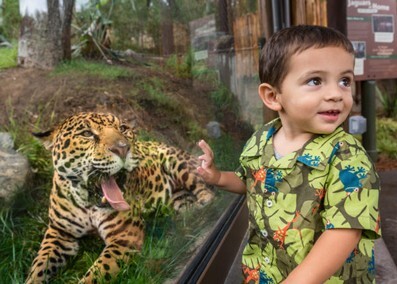
As AZA has evolved, a few notable and important events have shaped how they present themselves as a non-governmental organization trying to regulate with the same authority as the federal government , 1;) their partnership with HSUS a few years back and 2;) their requirement for all newly hired keeper staff to have a bachelor's degree in life science, or animal science field. Once HSUS's influence took hold, the entire face of zoos changed completely, and it only took one decade.
Think of all of the new interns that went through the system to make that happen. Any people with free contact management backgrounds are immediately cast aside for fresh, new, and impressionable graduates that have very little animal experience. This has created a culture of keepers that go by a textbook instead of hands-on experience. This has also birthed another dangerous facet in keeping "code red" animals - a false sense of security. Because the keepers have never been up close with their animals, they do not understand a true physical relationship brought on by years of trust and consistency. This can lead to fatal errors for both animals and humans.
Old School: Dr. Lee Simmons of the Omaha Henry Doorley Zoo working hands-on with a Siberian tiger.

Lee Simmons III, 9, and an unnamed baby gorilla console each other during a bout of chicken pox in 1971.
The baby gorilla was kept at zoo Director Lee Simmons' home after coming down with the childhood disease.
Lee's children both had it, too.
AZA touts itself as the "gold standard" of animal care in North America. It markets its accreditation to the general public and the government as the ultimate saving grace that separates them from private owners and so-called "roadside" zoos. After Dan Ashe, a good buddy of Wayne Pacelle, formerly of HSUS, started this description of AZA, that's when things started to get sketchy. They purposefully used this language to snub ZAA (Zoological Association of America) facilities in an effort to discredit them; a tactic they would go on to use time and time again to use in their favor for exemptions in legislation regarding exotic animals.
Recently, a male tiger killed his mate at the Point Defiance Zoo in Tacoma, WA after they were put into the same habitat to breed as directed by the powers that oversee the SSP. Despite careful introductions, the male inflicted severe wounds so severe the female succumbed to her injuries.
A pattern has developed in zoos that follow this strict SSP model where despite careful consideration, one of the two mates dies during the interaction. Put plainly; if it had been a circus, it would have been shut down immediately. What is disturbing is that these fatalities are noted and then chalked up to just another routine day in the life of a zoo animal since they could have potentially died in the wild of the same fate. However, they are not in the wild and should not be managed as such. They are in our care and deserve to be completely safe and protected. Otherwise, what would be the point of a so-called species survival plan?
A species survival plan that has lost 4 adult tigers in the past 15 months. One that mandated no direct contact with a mother tiger and led to the death of a cub that was not receiving enough milk when nursing and therefore starved to death. Survival is not the priority if ALL measures of safety and husbandry are not considered when managing the animals.
Now take the country of India, for instance. We looked at the tiger conservation efforts and found a very different framework for the AZA's plan and the idea of tiger conservation. Currently, the AZA, Species Survival Plan, (SSP) for tigers includes three subspecies, the Amur, Sumatran, and Malayan tigers. They also have one other class for SSP tigers, the "generic tiger". The AZA states that this is a Yellow SSP Plan, and "it's goal is to reduce the population of generic tigers in AZA-accredited zoos."
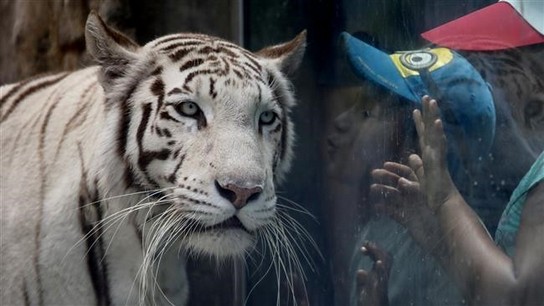
When the AZA brings an animal into the SSP program, the AZA garnishes a tremendous amount of controlling "say so" within that animal's home territory. However, India, the home of the Bengal tiger species (panthera tigris tigris) has not participated (or given in) in the AZA's SSP, and thus has maintained the control of the conservation activities with this species.
India's wild Bengal tiger population has soared over 33% in the last 5 years, and now India has about 71% of the world's wild tiger population. None of the tiger species that the SSP are currently managing have seen any significant increase over the decades. In fact, the AZA Tiger SSP is now making their number one task to "maintain sustainable, genetically diverse tiger populations as a "genetic insurance policy" for their wild counterparts".
While the AZA's Tiger SSP is failing,
India's Bengal population is soaring.
So while India is showing the rest of the world that true and realistic wild tiger conservation works, the AZA and it's SSP program, along with it's $22 billion dollars a year in revenue, seem to be telling us that the end is near for the tiger species in it's control. But don't worry, they will have captive breeding stock, right?
Sources indicate that there are just over 2,400 zoos in the United States (USA World Report). With only 233 that are "accredited" by the AZA, (10%). The AZA's CEO Dan Ashe touts that this low amount is due to the AZA having the "gold standard" for it's accreditation requirement.
By definition, Ashe may well be right. Merriam-Websters definition of the "gold standard" is "a monetary standard under which the basic unit of currency is defined by a stated quantity of gold and which is usually characterized by the coinage and circulation of gold", and is an outdated standard that was dropped in the 1930's.

Dan Ashe, CEO
Association of Zoos and Aquariums
It is no secret that the AZA is a large "union-type" operation. Under the quasi of "conservation", a zoo facility must abide by their rules and directives or be kicked out and black-labeled. The Executive Director (Dan Ashe) with the AZA recently touted in a Congressional public hearing that:
"AZA's 233 accredited aquariums, nature centers, science centers and zoos annually see more than 195 million visitors, collectively generate more than $22 billion in annual economic activity" (Read the transcript here)
To put that in a little perspective, $22 billion dollars would fully equip two nuclear aircraft carriers will all their aviation assets, 100%.

The AZA could buy two nuclear aircraft carries each year with their claimed revenue impact.
As noted, just the last fifteen (15) months, eight (8) big cats in the AZA-SSP have died under these "gold standards";
- September 2023: Rare Amur Tiger dies at AZA zoo under vet care.
- October 2022: Indianapolis Zoo Amur tiger cub dies due to health complications.
- July 2022: The Birmingham Zoo under the direction of the AZA’s SSP, recommendations to attempt a breeding with “Josh” and “Akili”, (African Lions), resulted in “Akili” being killed by her attempted mate “Josh”.
- March 2022: Another rare AZA/SSP Amur Tiger dies unexpectedly during routine exam. “Putin”, a 12-year-old Amur tiger, died on Wednesday (03/23/22) at the Minnesota Zoo during what the zoo says was a "routine exam".
- Dec 2021: Naples Zoo: Rare Malaysian Tiger is shot after hours in its enclosure after a man climbed over a 4.5 foot fence to pet the tiger.
- Oct 2021: Point Defiance Zoo: While attempting a breeding introduction, the male tiger attacked and killed his potential mate.
- May 2021: Zoo Boise: While conducting a routine physical exam of their male tiger, he died under anesthesia.
- May 2021: The Toronto Zoo lost the second baby Amur tiger cub. Both passed away in less than 30 days of birth.
- March 2021: Cheyenne Mountain Zoo: Female tiger dies while undergoing an artificial insemination process.
Big cats are not the only lost species to the "so-called" AZA's gold standard of animal care. The Dallas Zoo has experienced several notable deaths in recent years:
- In October 2021, the three month old giraffe, which was noticed to be limping was examined by zoo veterinarians and discovered that "Marekani" had dislocated her right elbow and fractured her growth plate, radius and ulna somehow without anyone noticing. Given a grave prognosis with no possibility to recover, the team made decision to euthanize "Marekani" .
- Just one week after "Marekani's" death, a 19 year old, "Auggie" of unknown causes at the time.
- In July 2019, just weeks after an introduction that zoologists said had gone better than expected, African painted dog "Ola" was killed by her two packmates.
- June 2019, "Witten", another young giraffe died while undergoing a routine exam. The zoo necropsy showed that he thrashed around before the sedative took effect and broke a bone in his neck, which killed him almost instantly.
- "Adhama", a 7-year-old hippo who died suddenly of heart-related complications from a viral infection in October 2018;
- "Kipenzi", the 3- month-old giraffe who died instantly when she broke three vertebrae in her neck in July 2015;
- "Kamau", a popular 6-month-old cheetah cub who died of a respiratory illness in January 2014;
- "Johari" , 5-year-old lioness who was killed by one of the zoo's male lions in November 2013.
In the meanwhile in the midst of these failures the AZA is constantly petitioning law makers on all levels to exempt facilities under its accreditation from laws related to zoos and other related exhibits and parks.
Not a single word from PETA, Why is that?
One thing we found extremely interesting is the complete silence from the People for the Ethical Treatment for Animals, (PETA). A simple Goggle search reveals that PETA will release about 20 media style releases's per week on just about any topic related to animals.
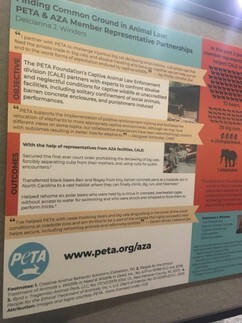
But not this time!

It's been months since this tragic incident, and not a single word from PETA. Wonder why this is? We found this report very interesting, Why is AZA Allowing PETA in its Conference?
... more to come
Related Stories:



